
Between Dynasties
2012, Cairo, Giza, Memphis, Saqqara, Dashur
EGYPTAFRICAARCHAEOLOGYMUSEUMS
Back at the hostel over a sugary black tea and an unasked-for shoulder massage, my smiling, tactile host told me that he trusted the military council then ruling the country. This was an interim government which took over after Mubarak surrendered power, and later on they would ultimately keep their promise to hold elections in the summer of 2012. The Muslim Brotherhood under Mohamed Morsi was then swept to power. A coup d'etat toppled that new government just a year later after Morsi's attempts to implement a new, Islamist-leaning constitution sparked a backlash and emboldened the military to seize power. All of that was still in Egypt's future when I visited, but I think I caught a little of the foreshadowing.
It must have been the first or second morning in Cairo and a man on the street by the name of Ali asked me to use my passport to buy him duty-free cigarettes, which for some reason you can do some tens of kilometres outside of the airport. I obliged, of course. He said he knew I would; I had a friendly face. I saw him again the next day and he invited me to socialise with him. It was interesting for me to experience the Egyptian equivalent of having a drink; we sat outside leisurely chomping sunflower seeds and smoking hookah. Afterwards he brought me to a sort of nightclub where we watched a belly-dancer, and it transpired that Ali did in fact consume alcohol. For me it was an odd enough place, it didn't follow the patterns I was used to. In my memory it's a bit like a cave, with small square compartments huddled between black walls, all filled up with hookah smoke and patrolled by an excess of anxious waitresses. Our plates of snacks were topped up after almost every bite, and ditto our glasses after almost every sip. In the dim light, Ali told me, I suppose unsurprisingly, that he preferred the old system. He knew the Muslim Brotherhood were in the ascent and he was afraid there would be a clamp-down on his favourite things, his beer and liberal-minded women. He showed me pictures on his phone of his purported foreign conquests, and scolded me for not conniving likewise in Ethiopia. I suppose he was obnoxious, but at the time I was happy enough to pretend he was only brazen. At the end of the evening he paid our bill without saying a word and appeared to tip the waitress generously. Outside, it was a cool night and a short walk to the crossroads where we'd part ways. As we approached it, Ali turned around and put out his hand, flat. Apologetically, I quickly took out what I figured would cover my half plus change and put it into his palm with a nod. But he looked gravely at the bank notes, and there was an unpleasant silence. "What is this?" he asked me pointedly. I told him it was my part, and he began to fidget, looking up and away and then fixedly back at me. "Give me the rest, now". My surprise was total, and I could only pause awkwardly while my brain rushed through some social arithmetic. Maybe in Egypt it's the guest that pays for the host? Have I given off some cue by mistake, or did he figure it was natural for the moneyed Westerner to cover things? Or did he just want to entertain himself at my expense all along? I told him his request didn't seem right, and he again demanded the money. Finally I gave in, reasoning that I'd rather take the hit and be on the right side of things. I don't remember how much it was, but it was an expensive night by Irish standards. As I placed the money in his hands I told him again that I didn't like it. I think he actually counted the notes, under a grim countenance, and then we bade each other a cold goodnight. I did see Ali once again on the street, and I think he wished me well on my travels or something to that effect. But the colour was gone out of his face. Years later an Egyptian friend assured me that this isn't how things are generally done, and furthermore to the contrary, stories of generous hospitality were usually the first order of business in any conversation with a fellow traveller during my visit. Nevertheless, I guess my misunderstanding with Ali stemmed at least in part from different sets of expectations, rooted in where we each had come from. If it was a hustle it was an odd one.
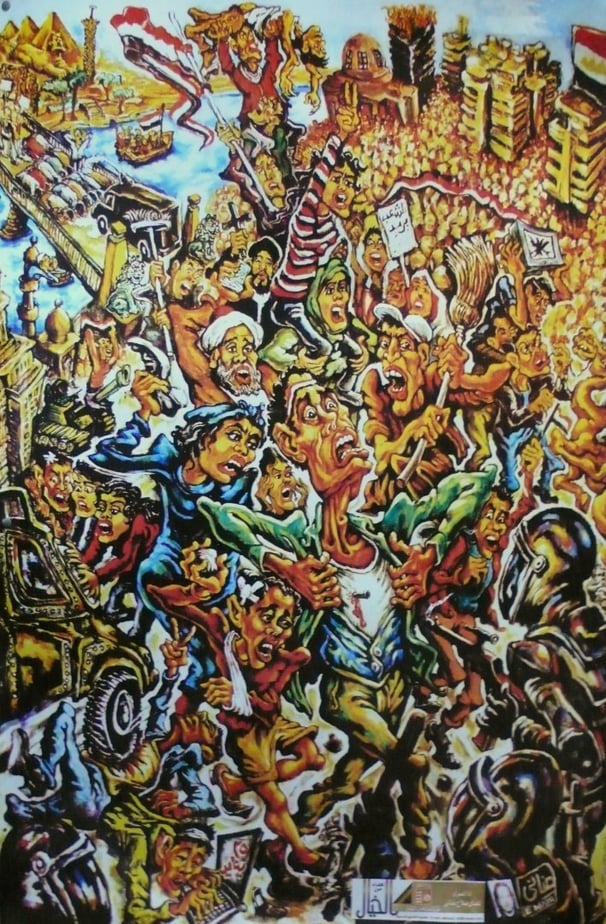

Springtime in Egypt
I remember sitting on a chair in Addis Ababa's Bole airport, waiting for my flight to Cairo. I was confused, and what's more I didn't know it. There was only a strange feeling in my stomach and a mash of images swimming in my head. I was still processing how things had gone with someone I met in Ethiopia. It was something special for me, but I parted ways with her anyway, without it even crossing my mind to delay my planned journey onwards to Egypt. Now as I write I'm looking at the old visa in my passport. Sure enough, I could have stayed on till April, but I left for Egypt at the end of February, seven years ago.
The airplane carried me harmlessly over the rumoured turmoil of South Sudan, a country then just a year old. That vague sense of emotional indigestion receded further into my gut and the elation of stepping into the unknown came again to the fore. It was dark when I landed. The first Egyptian I met was a mustachioed rectangle of a man, a taxi driver, and he bounded assertively up to my side in the arrivals lounge and clasped me around the shoulders. Stunned, I limply demanded to know the fare as he marched me out to his taxi. There was a short, keen-eyed American traveller sitting in the back of the car, whose face I recognised. He reassured me that we'd split the fare to make it something reasonable, and I relaxed, and allowed our chauffeur to put my bag in the boot. With that done he seemed to decide that two was enough. He threw a quick glance at the hostel address I'd scribbled down and then motioned me urgently into the back, sealing the door behind me, and without further ado he started the engine and propelled us into the Cairene night. The city loomed huge and sprawling around us, and I felt a little more thankful for the driver. At least he'd get me where I was going and fast, if only to dispose of me and move on to his next fare. We chatted lightly in the back. The American had just arrived from Ethiopia too, and he had seen me on the bus to Harar. He was curious about the female companion he'd seen me with, and implicitly, her present absence, and I became defensive. When he went on to say that I didn't have a proper Irish accent, it was settled for me that we wouldn't be making friends. I was relatively closed to his story then, of having crossed the Red Sea to Yemen with a boat-load of goats, and to his advice regarding the Egyptians. Theft, he said, is considered as shameful in Egypt as anywhere else, but to extract money from the unwary by guile carries no such stigma. I recalled the gentle, embarrassed face of an Ethiopian trader who had once quoted me an inflated price for laundry in Gondar, and juxtaposed it mentally with the iron brow of the man now behind the wheel.
My hostel was located a short walk from Tahrir square, where a few demonstrators were still encamped in tents a year and a month after the January 2011 revolution. On my first morning in Cairo I paid the place a visit, it being the epicentre of so much drama I'd seen on television. The portraits of young martyrs stared solemnly from posters here and there, accompanied by Syria's Bashar Al Assad, defaced with a Hitler moustache. The nervous energy of the revolution was still there, itching for new battles; the green, white and black flag of the Free Syrian Army was a common sight, often flying alongside the new flag of Libya post-Gaddafi. Egypt's own banner had not changed. The red, white and black stamped with a golden eagle was flying proudly throughout the city, reclaimed from the Mubarak regime by the revolutionaries.
The Revolution. A painting in my Cairo hostel.
Islamic Cairo
In greater Cairo there are some twenty million people, and I felt like I met most of them in the week I spent there. It's the largest and most densely populated city in either Africa or the Arab world, categorising as you will. By some distance it was the biggest city I had ever visited myself. The weight of humanity is tangible there, made all the more pronounced by the lack of green space; supposedly just one footprint per person. To me the streets were a mad bustle, and at any given junction it seemed like there was always someone laughing, someone arguing, someone else praying, several more trying to sell me something, and bizarrely enough someone else sitting down relaxing right there in the thick of it. In spite of the size and confusion of the place, most of the sights a tourist will be aiming for can be reached from the centre with a bit of walking plus the metro. My impression of the underground system was that it seemed effective, if fairly limited considering the amount of people and the size of the geography it has to serve. I remember noting with interest the special carriages reserved for women, taking care to position myself further down the platform with the men. When the train arrived the crowd imploded into it, and I hesitated to join them just as the doors shut. I was only saved from the sandwich by another passenger yanking me inside. No room for a European's personal space between the desert and the Nile.
My first big expedition was to the city's old town, known as Islamic Cairo or simply Old Cairo. The district has a real Arabian Nights feel, defined by its elegant, sandy beige mosques and the twists and turns of the Khan el-Khalili souk. As I wandered around outside the grandiose Al-Azhar mosque an outwardly friendly man introduced himself as the muezzin, the special mosque attendant chosen for his good character and entrusted with singing the call to prayer from up in the minaret. He offered to show me around inside the mosque, and so I removed my shoes and let him guide me around the carpeted halls. I especially remember a large columned room where hundreds of men must often gather to pray, though at the time there were only a few boys and old men sitting around, studying their Qurans. It was airy and filled with light, unimpeded by its regular white stone pillars and drawn in by a warm red carpet. My mind also goes back to the central courtyard within the mosque under a cloudy grey sky, a pristine white and beige space peacefully ensconced from the megalopolis beyond.
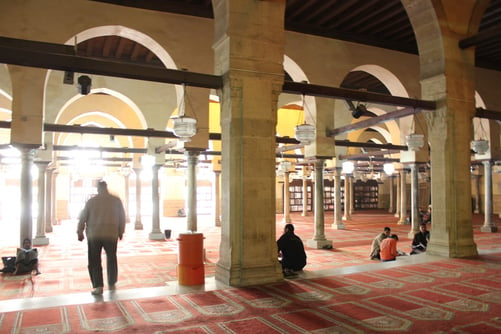
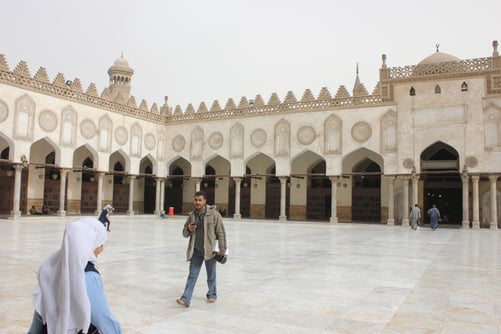


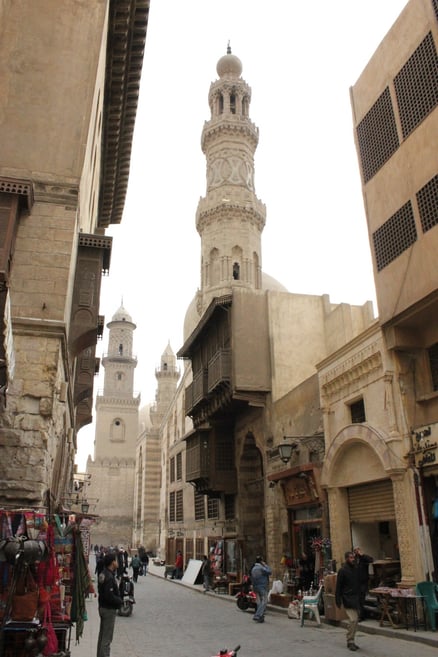
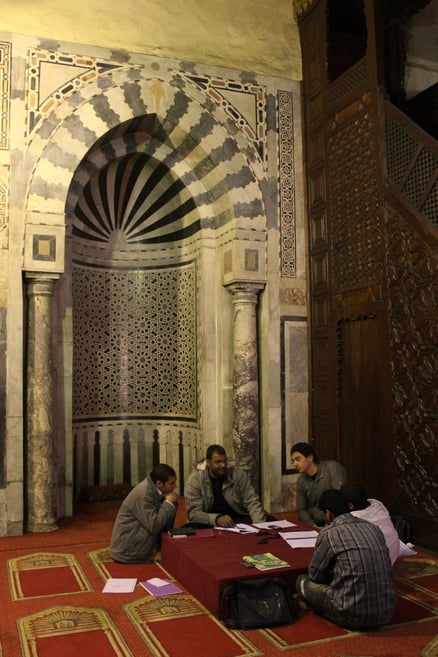


Al-Azhar mosque interior, Courtyard
It slowly became apparent that the muezzin and I had entered into a professional relationship. From the rehearsed and structured tenor of his tour and an increasingly business-like coolness in his manner, I understood that I was going to have to pay for his services. It wouldn't be called paying though; this was to be my first experience with baksheesh. Variously meaning alms, a tip, or a bribe, baksheesh is not confined to Egypt, and the request can be heard throughout the Middle East and South Asia. Nowhere else in the world though have I heard the word as often, or been as wearied by it. Egypt has been on the receiving end of tourism since before there was even a word for it, and so a regrettably ugly sub-culture of hassling foreigners has had a long time to develop. I suspect my experience of it was also worsened by the plunge in tourist numbers around the time of my visit, not long after the revolution. In stark and relieving contrast to this, in Egypt as in the whole of the Middle East there is also a strong tradition of hospitality towards strangers, and I not only heard tell of it but saw plenty myself. I remember warmly how a random man I hadn't even spoken with shared his lunch with me at a train station, a security guard on the street had me drink tea with him, and the family running my hostel in Cairo invited me to join them for breakfast. It seemed to me there were two contradictory cultures existing side by side, one where I was treated with absolute kindness and generosity, and the other where the interaction could be cold and uncomfortable, or even hostile. I think you can develop a nose for who's who, but failing that the simple rule of thumb is to forget about making friends while you're near a tourist attraction. That's not to say you should be rude, just give your pursuers a firm la shokran (no thanks) and don't stop walking. Approached by a stranger away from the sightseeing, you might just be more fortunate. If you let your guard down though, do keep your wits about you.
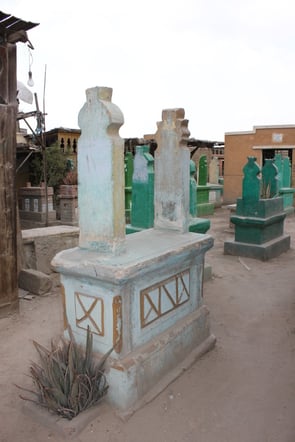
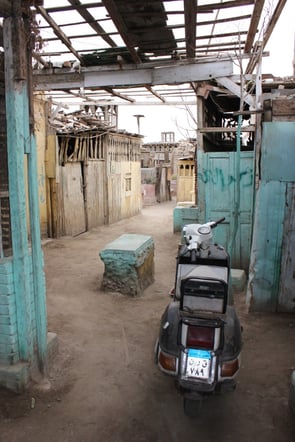


City of the Dead
Returning to our muezzin, he wasn't all that bad in the finish, though he was cheeky enough to frown at what I gave him. By that point I felt he'd earned something for guiding me around not only his mosque but a lot of the old town as well, though I didn't and still don't accept as legitimate this tactic, luring the tourist in with supposed friendliness and then making them feel indebted. He brought me as far as the City of the Dead and no further, where I thought he redeemed himself a little by insisting that I wasn't to hang around after dark. This place is a necropolis, a vast monumental graveyard, though now there are plenty of the living making their homes among the tombs. Beginning in the 1950s people came to live here after their neighbourhoods were demolished to make way for urban renewal. This population was later bolstered by migrants from the countryside, and again in 1992 by people made homeless by an earthquake which shook the city in that year. The muezzin threw me an ominous look over his shoulder after his parting advice, and I decided not to linger long. I must have only penetrated a little beyond the perimeter of this strangest of neighbourhoods. It has been called a slum, but what I saw seemed to be fairly well taken care of, though it was no less the odd for it. There were makeshift houses stacked on top of or wedged in between tombs and mausoleums, and beside the graves there were doorways, painted walls, parked vehicles and tended plants. Eerily enough though I don't remember meeting anyone there, under that grey, darkening sky. If I hadn't taken any photos, I might wonder now whether I'd actually been there at all and not just dreamt it.
Egyptian Museum
The City of the Dead makes a nice metaphor for the country as a whole; a thin slice of inhabited ground that has nursed and buried numberless generations, such that the living have to strain to assert themselves over their predecessors. To understand what I mean you should visit the Egyptian Museum. It contains an absolute embarrassment of archaeology; I felt like I could visit it twice or three times and still miss plenty. I remember a kind of central foyer on the ground floor, adjoining many surrounding rooms which seemed to creak under the weight of the artefacts they displayed. In this foyer there loomed a pair of giants; the colossal statue of the Pharaoh Amenhotep III and his wife Tiye. If the artist was any way honest they must have been an impressive pair in life; their serene, handsome faces crowned slender but powerful physiques, all got up in the simple but majestic head-dresses of the ancient Egyptian royals. Amazingly, their mummies are housed in the very same building, and so I checked to see if there was any resemblance. Amenhotep is just a skeleton now, but the years have been kinder to Tiye. Her long hair still falls around her, and by her broad shoulders, her long neck, and the contours of her face, there was still enough there to suggest that this indeed had once been a beautiful woman. Her son was Akhenaten, one of the most ambitious or eccentric rulers of ancient Egypt. He moved the capital to a new city at Amarna, and attempted to dump the intricate Egyptian polytheistic religion for what some consider the first monotheism, the exclusive worship of the Aten, the sun. His reforms did not survive him, however. His son after him was born Tutankhaten but died Tutankhamun, the boy king fated to achieve little in his short life, though in death he might be the most famous pharaoh of all simply because no grave robber ever managed to find him. The mummy believed to be Hatshepsut can also be seen in the museum. She was the most famous female pharaoh, a successful ruler and a prolific builder. In her statues she had herself portrayed with all the gravitas of her male predecessors, sometimes even complete with the protruding beard. It was strange to see the mummy of this and so many other larger-than-life characters, deprived of their epic tombs and reduced to something like a stuffed animal. I suppose there's an irony there if not exactly a justice, in that these were people who probably thought they were better than the rest, and now they've been put on display as curiosities for the public of the world. In a way, they've been given their immortality I suppose. Their stories are told and retold, and from their stubbornly enduring mortal coil a visitor like me will conjure them back to life in their imagination.
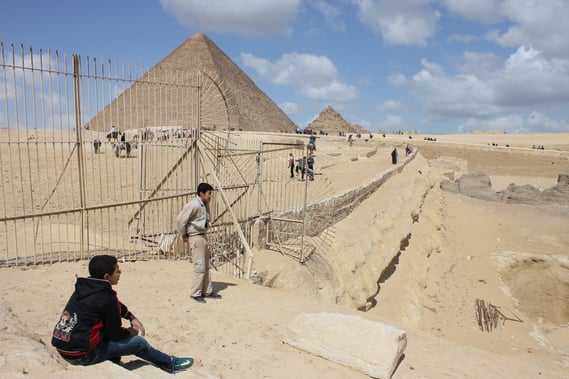

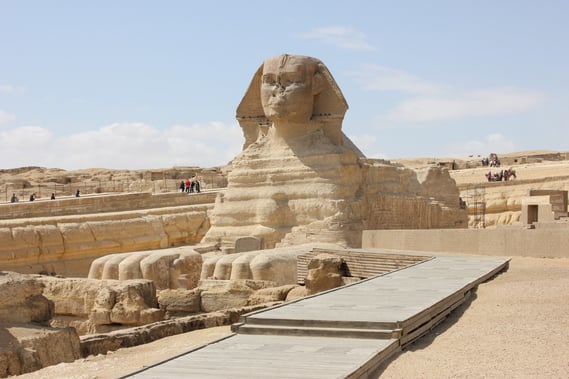
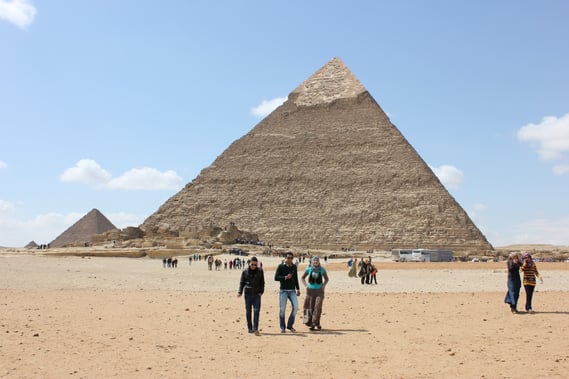
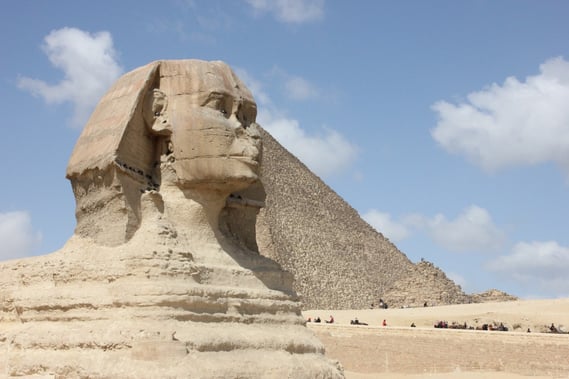
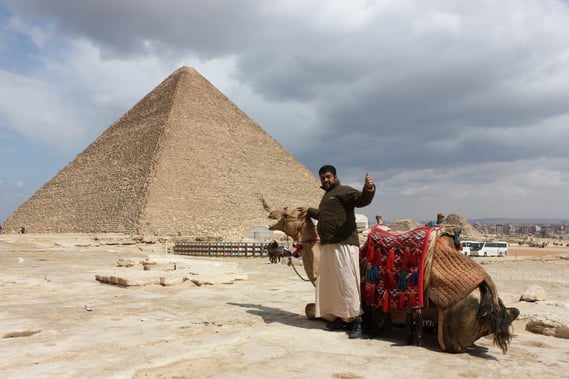






Giza Plateau
As much as those pharaohs trusted in the mummifiers' magic, they always kept a back-up plan for flesh and bone, and that was stone. The highlight of Cairo was, is, and will always be the pyramids and the Sphinx at Giza. This mortuary complex was built by a succession of pharaohs of the Fourth Dynasty of Egypt's Old Kingdom. In order of size, the three main pyramids are believed to belong to Khufu, Khafre, and Menkaure, and they are accompanied by three lesser pyramids. The Great Sphinx is thought to belong to Khafre. The Great Pyramid of Khufu is the only one of the ancient Seven Wonders of the World still standing, and it was always the oldest by a wide margin with a construction date between 2,580 and 2,560 BC. This means that when the Roman Empire conquered Egypt in 30 BC, these monuments were actually more ancient to the Romans than the Romans are to us.
Many visitors are surprised to find that modern Cairo has swelled so much that it surrounds the Giza Necropolis, and so rather than standing alone and aloof out in the desert, the pyramids today rule over a relatively small territory of sand bordered on four sides by the sprawl. There are still plenty of angles though from where you can forget about this, and the approach to the entrance in one of them. It all lived up to my expectations and beyond; my first glimpse of the Sphinx and those gigantic triangles looming behind it brought a big grin to my face. I think nothing can take away the mystery of this place, no matter how much the modern world encroaches, or how deep the archaeologists probe. On top of their tremendous age and size, there's a fantastic otherness to these structures, barely reduced at all by their fame. The mind boggles even more to mentally reconstruct their original appearance as you stand before them; it's believed the once-smooth faces of the pyramids were originally coated in shimmering white limestone, and their summits capped with gold.
After a few spellbound moments with the Great Sphinx, I began to walk in a happy silence around the pyramids, my head on a swivel. Unfortunately it was soon a silence I had to fight for. The few hours I spent at Giza were the worst for hassle from touts of the whole trip, and actually of my whole life. Those words for "no thank you", la shokran, were some of the very few I knew in Arabic, but by the end of the day I'd repeated them so many times that they'd turned back into gibberish. I was pursued on camel-back for paid photos with a real Bedouin, I had trinkets squeezed into my hands and payment demanded, I had pitches in my ear for everything from a fridge magnet to an illicit chunk of sphinx. It was beyond persistent and at points almost constant, as if there was a queue to have a go at me. The final straw came after I gave in and accepted a camel ride out to the perimeter of the site, almost just to have the paid protection from the other touts. I'd never been on a camel before, and the lurching back and forth was at least something new, if not very comfortable. To my guide's credit he brought me to a spectacular viewing point, taking in the pyramids in all their majesty. Sadly though, he felt he had to offset this at the end of the ride by trying to harangue more money out of me than we'd agreed at the start. He deployed that old chestnut, that he'd meant British, not Egyptian pounds. I think I actually laughed out loud at this, and after it got to shouting I simply refused to hear any more and trudged off through the sand. To my lasting regret, I'd let myself get so stressed out that I left Giza right then, before I'd had a chance to go inside the Great Pyramid. I suppose at least it's a reason to return some day. To the potential visitor, do bear in mind that the scarcity of tourists after the revolution probably didn't help matters. There's also the fact that I was alone; if I do go again I'll hire a proper guide, or better yet, visit with an Egyptian friend if I'm lucky enough to have one handy. If you are in Egypt though, make no mistake; Giza is unmissable, and no amount of hassle could ever change that.
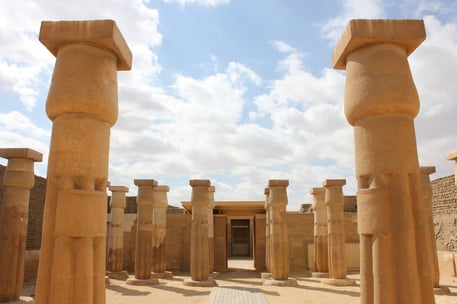
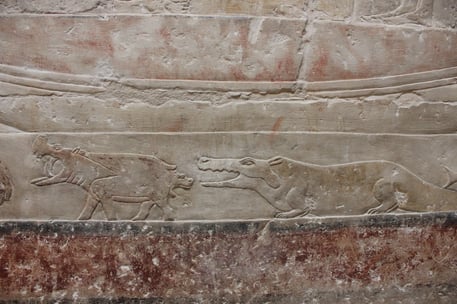
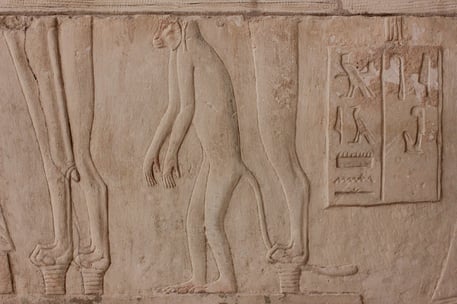
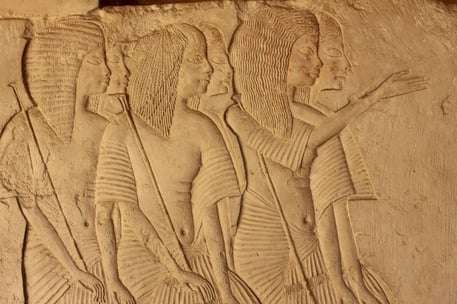
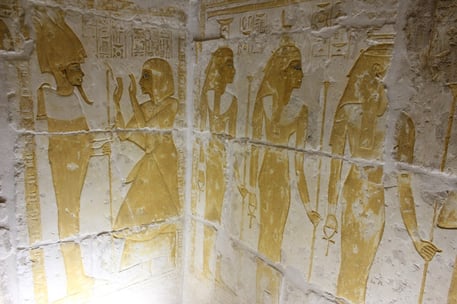





The Old Kingdom
Those aren't the only pyramids in Egypt though. Just an hour's drive south of Cairo you can visit the oldest one, the Pyramid of Djoser at the Saqqara Necropolis, close to the ancient capital at Memphis. Remarkably, we know the name of its architect, Imhotep. It is a stepped pyramid, like the pyramids in Central America, or a bit like the ziggurats of Mesopotamia. Egyptologists speculate that it might be a kind of missing link between the older rectangular tomb, the mastaba, and the later smooth-faced, true pyramids. Also at Saqqara you can visit the smallest Old Kingdom pyramid, the Pyramid of Unas, significant for the discovery there of the oldest known collection of ancient Egyptian religious texts. Although its exterior faces have crumbled it is possible to enter the subterranean chamber. My driver consoled me a bit when he pointed out that the interior here is more richly decorated than that of the Great Pyramid, and apparently less smelly. The descent was sudden and steep, a little claustrophobic but not nearly enough to compete with how intensely fascinating the whole experience was. When I finally reached the bottom and stood in the burial chamber, I looked up at the vaulted ceiling. From one side to the other, all very deliberately but with the simplicity of a child's drawing, it was covered with stars.
Back above ground, a complex of ancient enclosures stands not far from the pyramids. I took a look before leaving the site, and was surprised to discover that the interior walls were richly decorated with hieroglyphic inscriptions and illustrations, many retaining some of their original blue or yellow paint. There was a particular section barred by a locked gate, and the site attendant who was guiding me around copped the curiosity on my face. He gave me a conspiratorial wink and smiled, and after a brief hesitation I nodded, happy to see he wasn't selling it too hard. He unlocked the gate, entered, and stood to one side. This was a special moment for me; I had the place completely to myself. I scurried around taking photos of one panel after another, honestly on a high. Many depicted the pharaoh in some prominent pose, being fawned over by his retinue. There were many pictures of women, and it struck me that they would fit any modern stereotype of beauty with their lithe figures and long hair. One panel which had lost its paint seemed to show a group of children, elf-like with their little almond eyes, slender limbs and pot bellies. There were also many vivid depictions of animals. I saw a monkey hiding under a table, men fishing and butchering a cow, a mother hippo giving birth to a baby while a crocodile lurks ominously behind her. The animal-headed gods could also be seen presiding over humans; beaked Horus, snarling Anubis, long-necked Thoth. It was one baksheesh I didn't mind dropping.
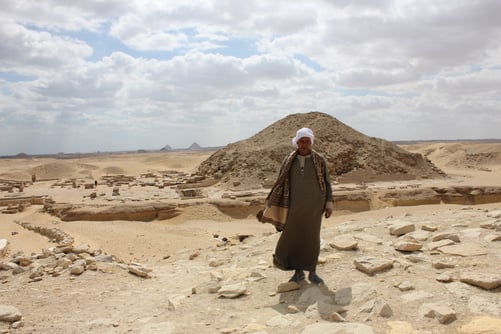
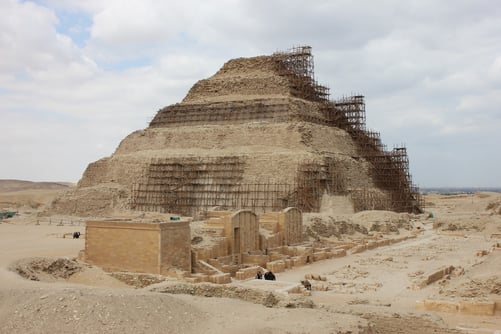


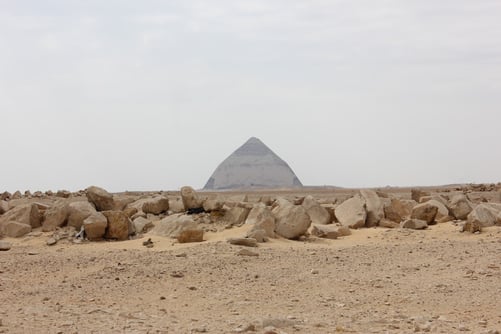
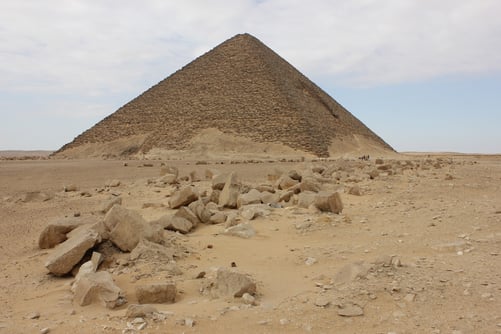


Memphis was once the centre of pharaonic Egypt but ultimately found itself left behind by history. Not long after Egypt was swept up into the empire of Alexander the Great, a new coastal city named after the conqueror rose to prominence; Alexandria. That city in its turn was replaced by Cairo under the Arabs. Little of ancient Memphis remains to be seen today, but it does hold an interesting museum, notable in particular for housing a colossal statue of Rameses II. Another few kilometres to the south I visited the Dashur Necropolis, site of two impressive pyramids raised by the Pharaoh Sneferu. The older of the two is the Bent Pyramid, so called because its angle of incline was reduced during construction about half-way up its height; it's thought the architects were concerned about a risk of collapse. They learned from this early experiment, and with the Red Pyramid they succeeded in building the first stable, true pyramid. It gets its name from the red limestone it was built from, though like the pyramids of Giza it would originally have been coated with that same pale limestone.
As well as playing host to so many interesting sights itself, Cairo is the centre of gravity in Egypt and the gateway to any onward travel in the country; north for Alexandria's Mediterranean vibe, west for the otherworldly landscapes of the White and Black deserts, east for your beaches or your Bible in the Sinai peninsula, or south to Luxor and Aswan. For my next steps it was the latter, and I was relieved to find the upper reaches of the Nile an altogether more easy-going country, though no less packed with history. Cairo will definitely see major transformations in the future as its population continues to boom and the new administration of Abdel Fattah el-Sisi asserts itself. "Giza 2030" is one such planned development, aiming to demolish the poor neighbourhoods which have grown up around the historic plateau to make way for a grand avenue leading up to the pyramids, new green spaces, hotels and other infrastructure, plus additions to the public transport system. As far as I can tell there are major questions as to the cost of the project and the fate of the people to be evicted, but at least one Egyptian friend of mine is optimistic that his capital's future is bright. I hope he's right, and that some day I'll be back to see it. I still have a pyramid to get to the bottom of.
The Gist: Cairo
ARRIVED: I flew to Cairo from Addis Ababa with Ethiopian airlines and then took a taxi to my hostel.
SLEPT: I stayed at Bedouin Hostel, booked through hostelworld.com
DID: Within the city I visited the Giza Plateau, the Egyptian Museum, Islamic Cairo and the City of the Dead. My hostel connected me with a driver to take me to several sites outside Cairo; the Saqqara Necropolis, the Dashur Necropolis and Memphis.
LEFT: I travelled by train (booked in person) south to Aswan.

